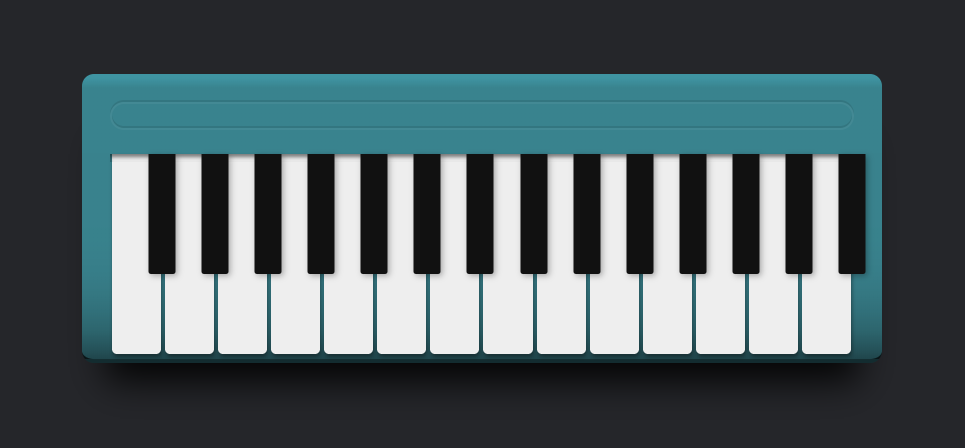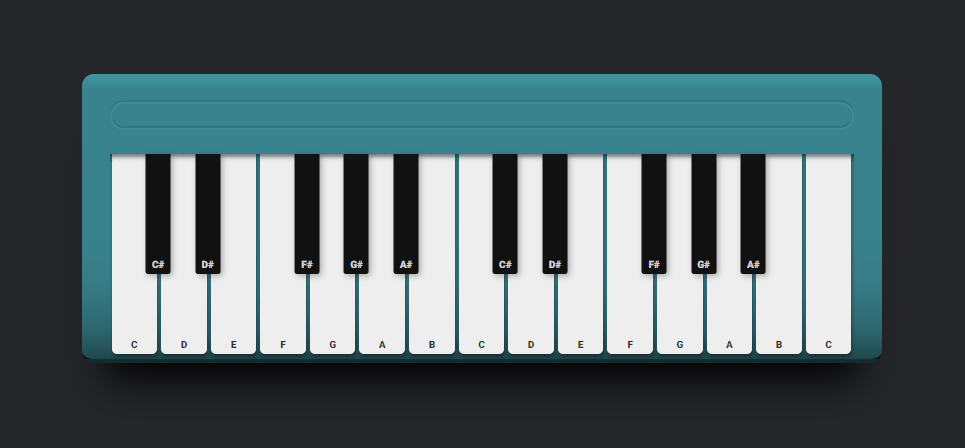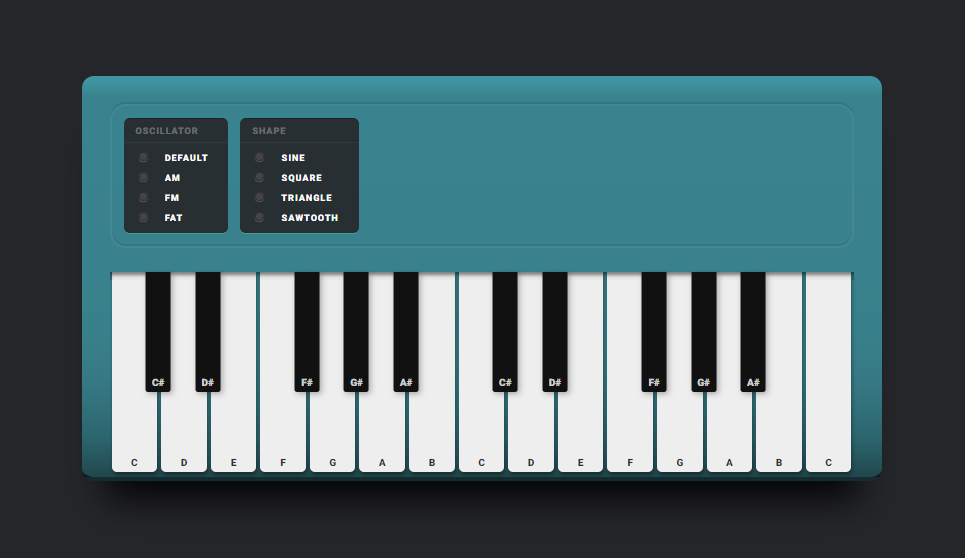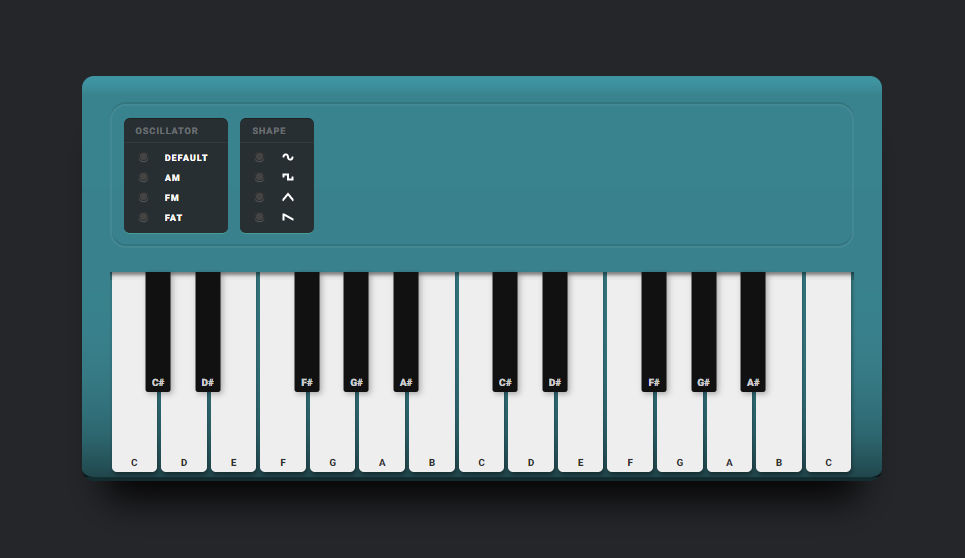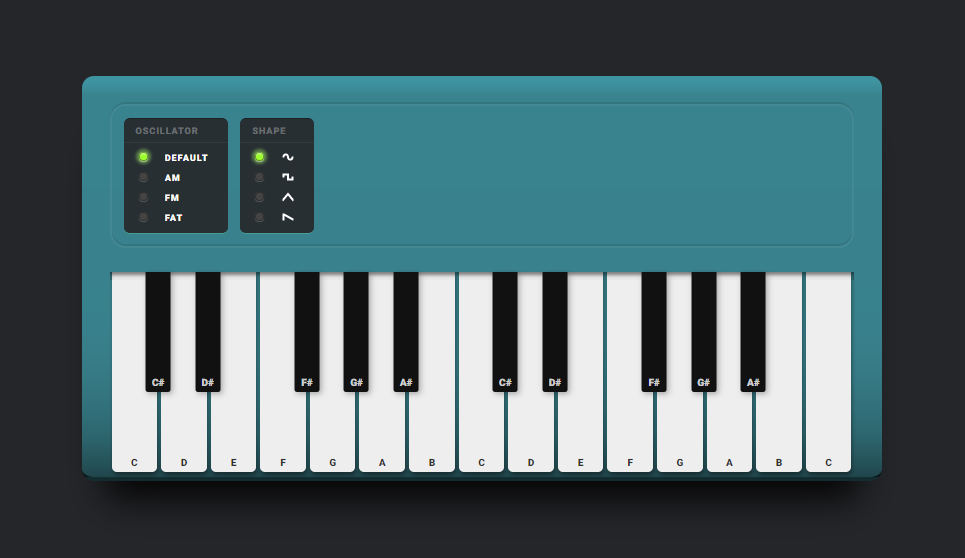We are going to build this little browser synth with JavaScript and ToneJS.
Live version at https://donmckenna.github.io/fireship.io-browser-synth
ToneJS is a JavaScript library which abstracts the Web Audio API out into a more musical syntax.
We're going to use some of its built-in oscillators and envelope adjustments to play with the sound of our synth as we play it, and we'll put it all together with vanilla JavaScript, CSS and HTML.
ToneJS-specific features we'll use:
- Instantiate a synth with
Tone.Synth()and hook it up to our output audio. - Build out template buttons to trigger notes with
Tone.Synth.triggerAttackRelease() - Build out template inputs to alter synth oscillators and envelope parameters by assigning values to
Tone.Synth().oscillatorandTone.Synth().envelope - Understand the parameters each of these options takes and why.
This article can be digested in 3 chunks:
- 1. Build a keyboad and use it to play ToneJS notes
- 2. Hook oscillator option groups into synth chain
- 3. Expand oscillator option group to accommodate different
<input>types
index.html isn't too special but we'll break down the special parts below.
<!DOCTYPE html>
<head>
<meta charset="utf-8">
<title>Pocket Synth</title>
<meta name="viewport" content="width=device-width, initial-scale=1">
<link rel="stylesheet" href="styles.css">
<script src="https://cdnjs.cloudflare.com/ajax/libs/tone/13.8.25/Tone.js"></script>
</head>
<body>
<div class="synth">
<div id="options-container"></div>
<div id="synth-keys-container"></div>
</div>
</body>
<script src="synth.js"></script>
</html>Inside the <head> tags, we can bring in Tone.js from cdnjs.
The version this article uses is 13.8.25, but you can check for updates here.
<head>
<script src="https://cdnjs.cloudflare.com/ajax/libs/tone/13.8.25/Tone.js"></script>
...
</head>After the closing <body> tag we can bring in the synth.js file we're about to create.
<html>
<head> ... </head>
<body> ... </body>
<script src="synth.js"></script>
</html>And inside the <body> tags, we can add the scaffolding we'll paint our JavaScript on.
<body>
<div class="synth">
<div id="options-container"></div>
<div id="synth-keys-container"></div>
</div>
</body>Your html and css should make this exciting container.
Now we can create our synth.js file.
Inside, we'll instantiate a new Synth() from Tone, and port its audio output to the playing computer's default master audio output, with .toMaster().
Without .toMaster() ToneJS won't know where to send its output and we won't hear anything.
const synth = new Tone.Synth().toMaster();Our Tone.Synth() has a method on it called triggerAttackRelease().
Think of Attack as the start of a note and Release as the end of its held duration.
We can trigger this method with a small synthKeyPress() function.
const synthKeyPress = note => {
synth.triggerAttackRelease(note, '16n');
};The parameters we're passing into triggerAttackRelease() are the note to be played (C4) and the subdivision of the note within its measure (16n).
C4 means we're playing a C note on the 4th lowest audible octave.
16n means the note subdivision is a 16th note.
You can read more about ToneJS notes / Frequency Type here
To better understand ToneJS's syntax, alternative accepted values could be:
D6to play aDnote2octaves higher than aC4.
4nto play a quarternote subdivision.
8tto play an8th notetriplet subdivision.
We'll keep track of our synth-keys-container and options-container divs to append generated keys and options to later.
const optionsContainer = document.getElementById('options-container');
const synthKeysContainer = document.getElementById('synth-keys-container');There are 12 notes in an octave. From A to G with all but 2 notes possessing a sharp (#).
We can translate this to an array of root notes to loop through and generate white and black keys with.
const notes = ['C', 'D', 'E', 'F', 'G', 'A', 'B'];We'll also set how many octaves we'd like our synth to have, and what the lowest of these octaves should be.
const octaveCount = 2;
const lowOctave = 5;...where octaveCount is the number of total playable octaves, and lowOctave is the number of the lowest playable octave (like the numeric suffix on C4 or D6, etc.)
For example, the above variables are saying our synth will have
2octaves which will be octaves5and6.
Let's create a new function to loop through our notes and octaves and construct our synth keyboard.
Loop over the octaveCount and increment through each iteration to later pass to our key presses.
const initializeSynthKeys = () => {
let currentOctave = lowOctave;
for (let i = 0; i < octaveCount; i++) {
currentOctave++;
}
}Within each octave loop we'll also loop through the notes of the scale we defined earlier and construct some appendable divs to organize the layout of our keys.
For each key we'll trigger a function on mousedown called synthKeyPress() which will send the appropriate note and octave data to our Tone.Synth() to play.
We'll append each to a container variable synthKeys which will become the innerHTML of our synthKeysContainer, and we'll stick each white/black key pair inside a <div class="key-group"> container for easier CSS positioning.
Additionally, each key shares a key CSS class and has its own white or black class to differentiate the two.
Updated initializeSynthKeys():
const initializeSynthKeys = () => {
let synthKeys = '';
let currentOctave = lowOctave;
for (let i = 0; i < octaveCount; i++) {
for (let note of notes) {
synthKeys += `
<div class="key-group">
<div class="key white" onmousedown="synthKeyPress('${note}${currentOctave}')"></div>
<div class="key black" onmousedown="synthKeyPress('${note}${currentOctave}')"></div>
</div>`;
}
currentOctave++;
}
synthKeysContainer.innerHTML = synthKeys;
}We'll make a function called initializeSynth() to trigger the entire keyboard building process.
It only calls initializeSynthKeys() right now but we can expand it later.
const initializeSynth = () => {
initializeSynthKeys();
};
initializeSynth();And now it should look like this:
Better than nothing I suppose..
We still need to account for root notes which don't possess a sibling black key, and that <div class="key"> repetition is a bit clunky so let's refactor this a bit and extract out the functionality to create any sort of key.
We can write a function which can create a white or black key.
This function takes in the color of the desired key, its note and octave.
Note the single quotes
''around${note}${octave}. We're using template literal syntax, combiningnoteandoctaveto make a new string to pass tosynthKeyPress(), so it's important we pass in an explicit string and not the variables themselves.
Also note the inclusion of
${note}inside the<div>which prints the name of the note on the key itself.
const createKey = (color, note, octave) => {
note = color === 'black' ? note + '#' : note;
return `
<div class="key ${color}" onmousedown="synthKeyPress('${note}${octave}')">
${note}
</div>`;
};We have a ternary seeing if the value of color is black or not, and adding a sharp (#) to the played note if it is.
The template string didn't change much, but it now uses the appropriate variables and its color class can be easily changed.
Let's update initializeSynthKeys() to use our new createKey() function.
const initializeSynthKeys = () => {
...
`<div class="key-group">
${createKey('white', note, currentOctave)}
${createKey('black', note, currentOctave)}
</div>`;
...
}Next, we can again write a small ternary helper function to tell us if the currently-being-constructed note has a sharp or not (E and B don't have sharps) and only create a black key (sharp key) if it does.
const noteHasSharp = note => note !== 'E' && note !== 'B';This is similar to writing something like this..
const noteHasSharp = function(note) { return (note !== 'E') && (note !== 'B'); };... (with some minor differences) but it can fit on one line.
And now we can use this helper function in another ternary to determine if a black key should be created.
const initializeSynthKeys = () => {
...
`<div class="key-group">
${createKey('white', note, currentOctave)}
${noteHasSharp(note) ? createKey('black', note, currentOctave) : ''}
</div>`;
...
}Which should look like this:
To finish our keyboard, right before applying the innerHTML, we'll top off the octaves with a single, resolving high C white key, using the currentOctave variable we made earlier.
const initializeSynthKeys = () => {
...
synthKeys += `
<div class="key-group">
${createKey('white', 'C', currentOctave)}
</div>`;
synthKeysContainer.innerHTML = synthKeys;
}The finished initializeSynthKeys() should look something like this:
const initializeSynthKeys = () => {
let synthKeys = '';
let currentOctave = lowOctave;
for (let i = 0; i < octaveCount; i++) {
for (let note of notes) {
synthKeys += `
<div class="key-group">
${createKey('white', note, currentOctave)}
${noteHasSharp(note) ? createKey('black', note, currentOctave) : ''}
</div>`;
}
currentOctave++;
}
synthKeys += `
<div class="key-group">
${createKey('white', 'C', currentOctave)}
</div>`;
synthKeysContainer.innerHTML = synthKeys;
};Refresh your page and your browser synth should look like this:
And you should actually be able to play it.
And we could totally stop there.
We could.
But we won't.
"Great," you say, "I've built a browser synth with only one timbre, but how can I add more variety to my oscillato-"
LESS TALK, MORE CODE.
Let's create an object housing different values we can apply to our synth oscillator. ToneJS offers a multitude of oscillator options and combinations, but we'll stick with basics here.
const optionsList = [{
title: 'Oscillator',
type: 'type',
values: ['default', 'am', 'fm', 'fat']
}, {
title: 'Shape',
type: 'shape',
values: ['sine', 'square', 'triangle', 'sawtooth']
}];The 4 main ToneJS oscillator wave shapes we'll use are sine, square, triangle and sawtooth.
Each of these shapes can accept an oscillator type prefix of am, fm, or fat, offering oscillator types within types.
Combining these, we effectively have 16 unique oscillators to play with.
We can build 2 sets of radio inputs from this object to combine these values into a string which ToneJS will accept for the synth oscillator type.
Synth oscillator
typeexamples:
sine
amsquare
fatsawtooth
You can learn more about type options by reading the .type Oscillator member here
We'll make an oscillatorVars object to keep track of oscillator type prefixes, and a synthVars object which contains the oscillator and envelope settings we'll reference and update later.
These settings can be passed right into our Tone.Synth() we made earlier.
const oscillatorVars = {
type: '',
shape: 'sine'
};
let synthVars = {
oscillator : {
type : 'sine',
},
envelope : {
attack : 0.1,
decay : 0.4,
sustain : 0.8,
release : 1.2,
}
};
const synth = new Tone.Synth( synthVars ).toMaster();We'll define a function which creates an option group (via a function we'll create soon) for each option in optionsList and appends it to the optionsContainer div which we defined earlier.
const initializeSynthOptions = () => {
let options = '';
for (let option of optionsList) {
options += createOptionGroup(option.type, option.values, option.title);
}
optionsContainer.innerHTML = options;
};...which we'll call alongside initializeSynthKeys() inside our initializeSynth() function at the end of synth.js.
const initializeSynth = () => {
initializeSynthKeys();
initializeSynthOptions();
};
initializeSynth();Similar to initializeSynthOptions(), we can create options with values from the option.values array, and build the template container for each option group.
const createOptionGroup = (type, values, title) => {
let options = '';
for (const value of values) {
options += createOption(type, value);
}
return `
<div class="options">
<span class="options-title">${title}</span>
${options}
</div>`;
};For each value we'll create an option passing in the option type ("option group type") and its value, using type to name our radio button and pass to updateOscillator() when the input has changed (onchange), and using value set the <input> value and <label> text.
const createOption = (type, value) => {
return `
<label>
<input
type="radio"
name="osc-${type}"
value="${value}"
onchange="updateOscillator('${type}', this.value)" />
${value}
</label>`;
};Next we can create the updateOscillator() function which will update the synth.oscillator.type with our <input>'s value when we switch radio options. We can update ToneJS synth parameters by simply assigning their values with =.
This function will also update synthVars.oscillator and oscillatorVars with the type and value to keep track of for future prefix / shape combinations.
const updateOscillator = (type, value) => {
oscillatorVars[type] = value;
synthVars.oscillator[type] = value;
synth.oscillator.type = `${oscillatorVars.type}${oscillatorVars.shape}`;
};An edge case we have to account for is the 'default' oscillator type. ToneJS doesn't need a prefix for its default state, but we probably want to provide something more descriptive than an empty string '', so let's add a check to convert a 'default' type value into the empty string '' ToneJS will work with.
const updateOscillator = (type, value) => {
if (type === 'type' && value === 'default') value = '';
oscillatorVars[type] = value;
synthVars.oscillator[type] = value;
synth.oscillator.type = `${oscillatorVars.type}${oscillatorVars.shape}`;
};Now we can save, refresh and ooo, look at those oscillator options :drool:
Some svg images would better convey the shape group options though, don't you think?
Let's add a ternary to account for this option, as well as update the variable the <label> uses for its content text.
const createOption = (type, value) => {
const valueContent = (type === 'shape') ? `<img src="assets/img/shape-${value}.svg">` : value;
return `
<label>
<input
type="radio"
name="osc-${type}"
value="${value}"
onchange="updateOscillator('${type}', this.value)" />
${valueContent}
</label>`;
};That's the stuff.
As a final order of business for the radio inputs, let's ensure the first default options are checked.
There are many ways we could accomplish this, but here we'll just pass in the index from the values array inside createOptionGroup(), and append the additional checked option for the 0th index within createOption().
If we want to maintain the for.. of structure inside createOptionGroup(), instead of getting the value directly from the values array, we can destructure the .entries() method found on the values array, and extract its value and index from there instead, passing both into createOption() to assess.
The updated createOptionGroup() for loop should now look something like this:
const createOptionGroup = (type, values, title) => {
let options = '';
for (const [i, value] of values.entries()) {
options += createOption(type, value, i);
}
return `
<div class="options">
<span class="options-title">${title}</span>
${options}
</div>`;
};The updated createOption() which determines the first radio option checked state, should now look something like this:
const createOption = (type, value, i) => {
const valueContent = (type === 'shape') ? `<img src="assets/img/shape-${value}.svg">` : value;
let additionalOptions = '';
if (i === 0) additionalOptions = 'checked'
return `
<label>
<input
type="radio"
name="osc-${type}"
value="${value}"
onchange="updateOscillator('${type}', this.value)"
${additionalOptions} />
${valueContent}
</label>`;
};Loops within loops.
Save. Refresh. Wonderful.
We'll have one last bit of fun and add some number inputs to mess with the oscillator's attack, decay, sustain and release envelopes.
You can read more about these envelope values in the docs here and in the wiki here
Let's refactor one last time and try to reuse some of these functions to include envelope number inputs as well as radio inputs.
Update optionsList wth these new envelope options.
const optionsList = [{
title: 'Oscillator',
type: 'type',
values: ['default', 'am', 'fm', 'fat']
}, {
title: 'Shape',
type: 'shape',
values: ['sine', 'square', 'triangle', 'sawtooth']
}, {
title: 'Envelope',
type: 'envelope',
values: ['attack', 'decay', 'sustain', 'release']
}];This list is then consumed by initializeSynthOptions() which itself doesn't need to change, but calls createOptionGroup() which needs to update its styles a bit to account for the new number input the envelope option group requires.
We'll add an 'envelope' class to the outer <div> if we detect the given type's value to be 'envelope', and an empty string if it's anything other than 'envelope'. Then just add this variable to the outer <div>.
createOptionGroup() should now look something like this:
const createOptionGroup = (type, values, title) => {
let envelopeClass = (type === 'envelope') ? type : '';
let options = '';
for (const [i, value] of values.entries()) {
options += createOption(type, value, i);
}
return `
<div class="options ${envelopeClass}">
<span class="options-title">${title}</span>
${options}
</div>`;
};createOption() is the function which renders the radio <input> we now want to conditionally render as either a number or radio <input>.
Let's expand this function's capabilities just a bit more and add a check for our 'envelope' type.
const createOption = (type, value, i) => {
const valueContent = (type === 'shape') ? `<img src="assets/img/shape-${value}.svg">` : value;
let envelope = '';
let inputType = 'radio';
let additionalOptions = '';
let valueAttribute = value;
if (type === 'envelope') {
envelope = value;
inputType = 'number';
additionalOptions = 'step="0.1" min="0.1"';
valueAttribute = synthVars.envelope[value];
// We know the type will end up being a radio option
// when not an 'envelope'
} else {
if (i === 0) additionalOptions = 'checked'
}
return `
<label>
<input
type="${inputType}"
name="osc-${type}"
value="${valueAttribute}"
onchange="updateOscillator('${type}', this.value, '${envelope}')"
${additionalOptions} />
${valueContent}
</label>`;
};Here we've checked if the type is 'envelope', if it is we update the variables which the returned template consumes.
-
radioinputs only need to consume thetypeitself. But for the'envelope'we also need to pass in thevalue. Here we store that inenvelopewhich we pass toupdateOscillator(). -
Change
inputTypefrom'radio'to'number'. -
additionalOptionsis just an arbitrary string you can add to your DOM element. Here it serves the sole purpose of constraining thenumber<input>'s steps and minimum value. -
Instead of passing
valuedirectly to the<input>'s value, we'll grab the entry fromsynthVars.envelope, and differentiate this new value fromvalueandvalueContentby naming itvalueAttribute.
Finally, since oscillator types and oscillator envelopes update slightly different values, we'll abstract their functionalities into two separate functions, updateOscillatorType() and updateOscillatorEnvelope(), and updateOscillator() can decide which to call.
updateOscillator() effectively becomes updateOscillatorType()
const updateOscillatorType = (type, value) => {
if (type === 'type' && value === 'default') value = '';
oscillatorVars[type] = value;
synthVars.oscillator[type] = value;
synth.oscillator.type = `${oscillatorVars.type}${oscillatorVars.shape}`;
};updateOscillatorEnvelope() can copy updateOscillatorType()'s structure, but will use the value of envelope instead of type. First it updates our global values to reference later, then assigns the specified envelope value to the synth.
const updateOscillatorEnvelope = (envelope, value) => {
synthVars.envelope[envelope] = value;
synth.envelope[envelope] = value;
};updateOscillator() now just needs to call updateOscillatorEnvelope() if there is an envelope value to update, otherwise it can continue calling updateOscillatorType().
const updateOscillator = (type, value, envelope) => {
if (envelope) updateOscillatorEnvelope(envelope, value);
else updateOscillatorType(type, value);
};Now we can change our envelope values, oscillator combinations, and play notes which filter through them all as you change them.
ToneJS is fun to fiddle with, and building your own expandable UI to fiddle with it with makes it more fun.


